

How Does Uncle Tim's Building Blocks Work?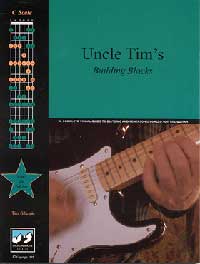
Simply! Here is the concept behind every page of UTBB.
On the fretboard of the guitar is a pattern of notes, once you learn it, you have immediate access to every scale in every part of the fretboard, for every key.
And it is easy to learn the pattern if you look at a picture of it, and music theory is what creates this pattern. This approach makes it super easy! Super easy!
There is nothing like it and nothing can make up for it. For $20, you can put this all to rest right now. Pick up a copy today.
eBooks are delivered instantly!
This month we are going to look at the physical matrix of diatonic keys. This is the crux of the Uncle Tim Series for Guitar and the single most useful tool for song construction I have ever used. It is the easiest way to examine many different options for constructing a song or extensions for any musical composition using any rules for construction. There are many different matrices in music. Usually we are working out of a diatonic matrix because most musical concepts are firmly rooted in diatonic frameworks.
The matrix is a comprehensive picture that will explain every diatonic concept in complete detail. Even though everything is contained in the matrix, it is still important to learn how it works. After 28 years of exploring this, I still find new reasons to study and explore it. So without any more flowery statements concerning it's usefulness, let's go look at some applications for this extremely useful tool.
I like to write songs. Not all of them are good, some I write and never play again. Most of the time I revisit the songs I write and keep them around for years. Sometimes I forget parts after I have put them on a shelf for a while, but with a little work I can replay them. I try to write them out in one form or another just so I can come back later and play them again. Much of the time I consult the matrix for ideas.
The diatonic matrix contains 100% of everything diatonic. Diatonic keys are the keys that western music is based on. For instance the matrix contains every diatonic scale for every key and all the chords in every key too. In fact the signature contains all possible chord inversions for every key. This means any chord in any key, no matter how complicated can be traced back to a chord covered in one of these inversions. The basic form will come from one of the basic triads found a key. We will examine some chords and identify where they came from to illustrate the complete nature of the matrix. In previous columns I have referred to the matrix as the diatonic signature. They are the same thing.
Introduction

 This
first diagram is the chromatic scale. It contains all the notes on the
guitar. Every and any note you would like to examine is in this pattern.
The problem with the chromatic signature is that it is too inclusive.
It gets to complicated to remember what is in the area of concern and
what is just additional information that can get in the way.
This
first diagram is the chromatic scale. It contains all the notes on the
guitar. Every and any note you would like to examine is in this pattern.
The problem with the chromatic signature is that it is too inclusive.
It gets to complicated to remember what is in the area of concern and
what is just additional information that can get in the way.
Since every key is contained inside it, you can use this signature to derive and highlight any key you want. The matrix or diatonic signature is contained within.
The second diagram is the actual diatonic signature. Of course it is contained inside the chromatic signature. The matrix, in this example, is positioned for the key of C major. If you are interested in exploring this concept, you can click on the link below and go back to previous newsletter columns and investigate this. Rather than focus on what has already been documented, we are going to investigate uses for it.
These are just two examples available for studying this enormously valuable matrix. There are others and I encourage you to explore all the back issues.
If you are interested in learning how to use it, I suggest starting with basic scales and building on that base of information.
Triads
 In previous issues
we have examined scales contained in this matrix, so for the most part
we are going to concentrate on triads and chords now.
In previous issues
we have examined scales contained in this matrix, so for the most part
we are going to concentrate on triads and chords now.
The first thing we are going to do is separate this into three string sets. Then we will diagram the chords inside them. The common chords are usually described in terms of inversions. An inversion is just a way to describe how a chord is formed. A basic chord contains three notes. The notes are described as the first, third and fifth degrees of the chord. You can start it with any of the notes and as long as you construct according to these rules you will be in the one of the first three inversions.
First Inversion 3, 5, 1
Second Inversion 5, 1, 3
Root Inversion 1, 3, 5
When these inversions are presented in the matrix, all the first inversion chords are shown in one diagram. The same is true for the other two inversions. Keep in mind you do not have to use only chords in one inversion, you can mix and match as you see fit. This greatly opens the possibilities for choices. You can also add additional notes to change the chord.
Here is one other thing to consider. At first this may seem overwhelming. Do not let it fool you. It is actually quite simple. It will take a few days to get comfortable with it. The theory behind this can be complicated but by using the diagrams you can easily use the chords and bypass all the theory that created it.
This information is from Uncle Tim's Book of Chords, which is quite advanced for standard diatonic keys. This is not beginner information but beginners can easily use the information and it will help with all other areas of playing guitar.
The First Inversion
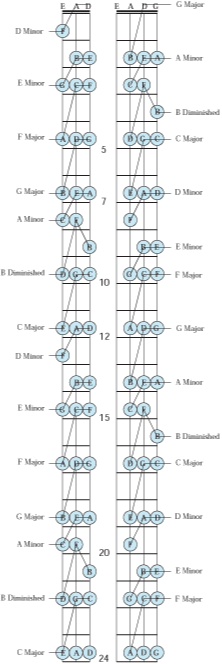
 Here
is a diagram of the first inversion triads for the key of C major and
A minor.
Here
is a diagram of the first inversion triads for the key of C major and
A minor.
The first diagram is the lower two, three string sets.
The diagram to the right contains the upper two, three string sets.
![]()
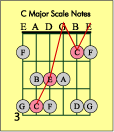 The chord shown in the yellow box is a typical C major chord. Notice the
notes are C, E, G. This is a root inversion C major chord. Do not
be fooled by the addition of the second C (on the B string) or the
second E on the open high E string. You can add any additional notes
of C, E and G. All it does is add more of the same notes. It is still
a C major chord. You can see it in the root inversion chords below.
The chord shown in the yellow box is a typical C major chord. Notice the
notes are C, E, G. This is a root inversion C major chord. Do not
be fooled by the addition of the second C (on the B string) or the
second E on the open high E string. You can add any additional notes
of C, E and G. All it does is add more of the same notes. It is still
a C major chord. You can see it in the root inversion chords below.
The sidebar is not what we are trying to illustrate. The whole purpose of this column is to show you the different opportunities to pick and choose chords to work with.
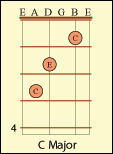
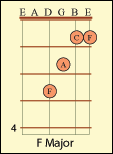
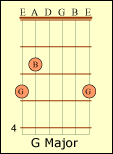 For
the sake of simplicity we are going to work with a simple three chord
progression of C major, F major and G major.
For
the sake of simplicity we are going to work with a simple three chord
progression of C major, F major and G major.
Here are some simple chord diagrams of these chords. Keep in mind these chords can occur in other areas of the fretboard and take on a different look. But as long as you use only the notes in the chord (and use all the notes), you will create another version of these chords.
So now let us take a look at how you can use the matrix to find new places these chords exist. Once you identify the location of the chords, you can try to figure out how to mix them in your song. Notice that all the other chords in the key are here too! Even though we are using a simple example, this same strategy can be used for very complicated progressions. If we assume we are playing the progressions in the order of C major, F major and then G major, we can see that you can play this sequence in different ways. The first example starts with C major in the middle, then moves up to F major and then drops down to G major. Depending on how you arrange things you can create a rising or falling progression. The second progression does the same thing.
The third progression starts low with C major, climbs very high to F major and then drops to mid-level to pick up the G major chord. This arrangement can sound quite different than the first two examples. The fourth example climbs steadily through C major, to F major to G major. This is handy for continually climbing up in pitch. Remember when one person is playing this progression, a second person can be laying a lead right on top of this progression or play the same chords in a different location and use accent notes too.
Remember these notes are all in the scale of C major which will go hand in hand with these chords. Consider what it would sound like if the lead uses the notes way up high in the matrix. The lead can be created by selecting notes in any part of this matrix. You can start low with an open string scale and then move way up high or to any other area. You can certainly jump around too.
Let's look at one other example using the root inversion set. Keep in mind the notes are still in the same matrix. We are not going to change anything other than the inversion.


Everything presented today is in Uncle Tim's Book of Chords. If you want to explore this further, you can do so by picking up a copy at our web site.
Root Inversion
 The root inversion can be a little harder to use since the fingerings
are more spread out and all contain a space between a note and the other
two notes.
The root inversion can be a little harder to use since the fingerings
are more spread out and all contain a space between a note and the other
two notes.
Here are a couple of things to think about.
1. You can always practice these chords as a scale of chords. This is great practice.
2. You can use any combination of these chords. Do not just play in one inversion because all the chords will have the distinct sound of that inversion. When you mix them up, you mask the individual sound of a specific inversion and give the listener more variety in the sound of the song.
3. Moving up and down the fretboard will also add interest to the piece.
4. You will get additional color if you add the open string notes. They are all in the key of C major and A minor, so you can almost add them without thinking.
5. Learn from your mistakes. Eventually you will play some notes that are not suppose to sound. Listen to these, sometimes you will find your mistakes sound pretty good. Keep them around if you find you like them.
6. Do not be afraid to throw in accent notes that are in the key but outside the notes of the chord. They can really add interest.
7. Mix in scale notes and even create walking bass lines or contrary lines of motion. Remember you can work up, down and across the fretboard. This gives you at least four different ways of moving.
8. Do not feel like you have to work only in the key. If you have some favorite chords, try them in the mix and see if they add the flavor you hope they will. There are a number of chords I will throw in just to see how they sound. They are in a group of my favorites and I look for chances to use them regardless of what key I can working in.
We did not even get to the second inversion examples and all of these examples use only three notes. You can certainly add additional notes to build up the chords.
The uses for this material extend far beyond these few examples. Just about anything you would like to add can be found inside this matrix. There are so many choices, it can be hard to see them all. The more you play with this material, the more uses you will find. Happy experimenting.